AMD Vs Intel: Motherboard Showdown
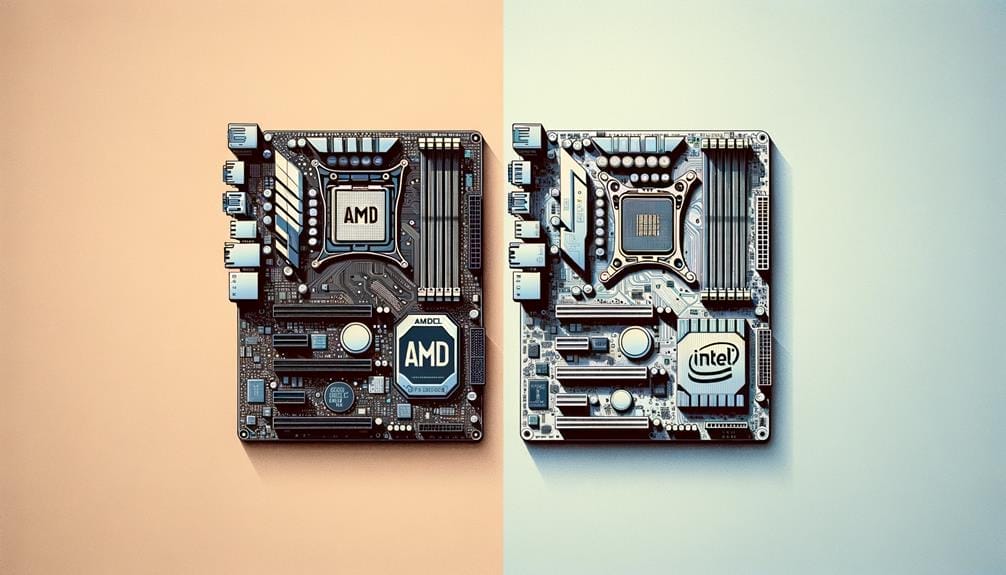
The enthusiasm for technological progress remains robust, highlighted by the intense rivalry between AMD and Intel in the computing sector. Think of the motherboard as the essential base of your computer, vital for boosting the performance of these processors.
Delving into the intricacies of motherboard selection, we are faced with a myriad of technical specifications, compatibility considerations, and future implications.
In this discussion, we will explore the nuanced differences between AMD and Intel motherboards, unraveling the impact of these choices on performance, scalability, and overall user experience.
Key Takeaways
- The motherboard is the central component of a PC, connecting and facilitating communication between all other components.
- Intel desktop motherboards are currently available at cheaper prices compared to AMD boards, thanks to support for DDR4 RAM.
- Most of AMD's motherboard chipsets allow for overclocking, while only Intel's highest-end chipsets offer the same capability.
- The choice between AMD and Intel motherboards depends on personal preferences and priorities.
Understanding Motherboard Compatibility
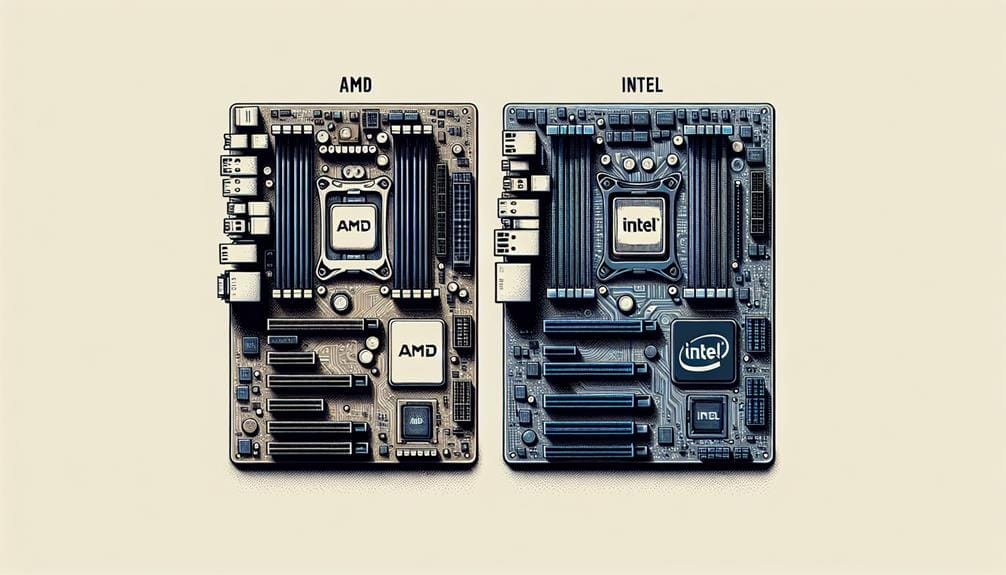
Understanding motherboard compatibility is crucial for ensuring optimal performance and compatibility of all components within a PC build.
When considering motherboard compatibility, it's essential to look at future proofing options to ensure that the system can accommodate potential upgrades. This includes examining the motherboard's CPU socket type, chipset, RAM compatibility, expansion slots, and connectivity options.
For instance, selecting a motherboard with support for the latest CPU socket type and RAM standards can help prolong the system's relevance and performance over time. Additionally, considering the availability of PCIe expansion slots for potential GPU or storage upgrades is important for future-proofing.
Price and Feature Differences
Continuing our exploration of motherboard compatibility and future-proofing considerations, it is essential to analyze the price and feature differences between AMD and Intel motherboards, as these factors play a critical role in the decision-making process for PC builders and enthusiasts.
- Pricing: Intel desktop motherboards are currently available at cheaper prices due to support for DDR4 RAM, whereas AMD is adopting a more premium approach with their DDR5-only socket.
- Overclocking: Most of AMD's motherboard chipsets allow for overclocking, while only Intel's highest-end chipsets offer the same capability.
- Extra Features: Pricing and availability of extra features like Wi-Fi can vary between AMD and Intel motherboards, impacting the overall value proposition.
- DDR4 vs DDR5: The transition to DDR5-only socket by AMD and the expected response from Intel are significant considerations for future-proofing PC builds.
These differences should be carefully evaluated based on individual requirements and preferences.
Overclocking Capabilities
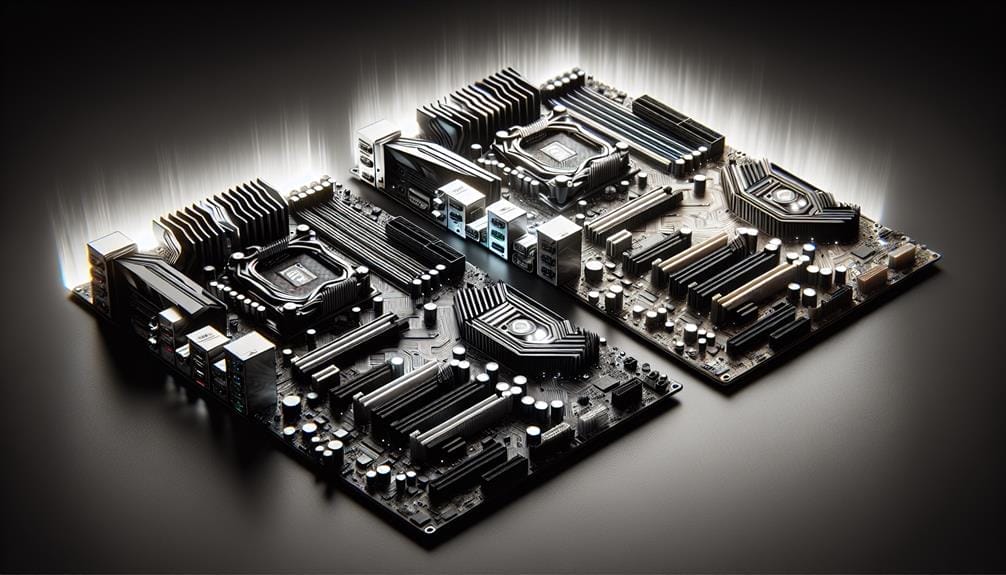
The overclocking capabilities of AMD and Intel motherboards play a pivotal role in maximizing CPU performance and are a key consideration for enthusiasts and professionals seeking to push system performance to its limits. When comparing the overclocking capabilities of AMD and Intel motherboards, several factors come into play, including supported chipsets, power delivery, and thermal management.
| Aspect | AMD Motherboards | Intel Motherboards |
|---|---|---|
| Supported Chipsets | Most chipsets allow overclocking | Only highest-end chipsets support overclocking |
| Power Delivery | Robust power delivery for overclocking | Superior power delivery for overclocking |
| Thermal Management | Effective cooling solutions for sustained performance | Efficient thermal management for stable overclocking |
These aspects directly impact motherboard performance and are crucial buying considerations for users looking to optimize CPU performance through overclocking.
Socket and RAM Requirements
When evaluating motherboard options for a PC build, considering the socket and RAM requirements is essential to ensure compatibility and optimal performance.
- Motherboard Socket Compatibility:
- AMD and Intel CPUs require specific sockets for installation, such as AM4 for current AMD CPUs and LGA 1200 for Intel's 10th and 11th Gen CPUs.
- RAM Requirements:
- DDR4 and DDR5 are the primary RAM types used in modern motherboards, with AMD AM5 motherboards exclusively designed for DDR5 RAM.
- Optimal RAM Configuration:
- Understanding the supported RAM speeds and configurations is crucial for maximizing system performance and stability.
- Future-Proofing Considerations:
- Considering future CPU and RAM upgrades ensures the longevity of the motherboard and overall system compatibility.
Comparison of Mainstream Models
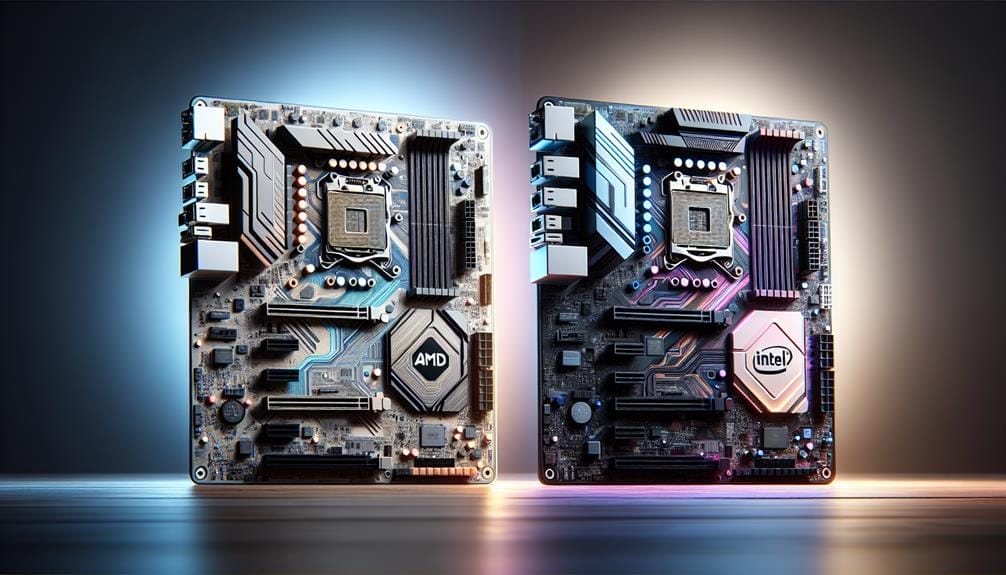
In evaluating mainstream models of AMD and Intel motherboards, a comprehensive analysis of their comparative benchmarks, technical specifications, and in-depth features is essential for informed decision-making. When considering motherboard performance, it's crucial to assess factors such as CPU socket compatibility, RAM support, expansion slots, and connectivity options.
AMD's mainstream models, such as the AM4 platform, offer extensive support for overclocking and are known for their compatibility with a wide range of CPUs. Intel's mainstream motherboards, particularly those supporting DDR4 RAM, provide cost-effective options with reliable performance.
Buyers should also consider the availability of additional features like Wi-Fi and the future-proofing potential of the motherboard. Ultimately, buying considerations should prioritize the specific requirements of the PC build, ensuring that the chosen motherboard aligns with the intended usage and future upgrade paths.
AMD's Premium Approach
AMD's shift towards a more premium approach, as evidenced by their adoption of the DDR5-only socket, signals a strategic move towards higher-end market segments and cutting-edge technology. This shift has significant implications for the motherboard market and PC enthusiasts alike.
- Enhanced Performance: DDR5 offers higher data transfer rates and lower power consumption, paving the way for high-performance computing.
- Future-Proofing: AMD's adoption of DDR5 socket ensures compatibility with upcoming technologies, providing longevity and investment protection for users.
- Competitive Edge: By embracing DDR5, AMD aims to outpace competitors and establish itself as a leader in the premium motherboard segment.
- Innovation Driver: The move towards DDR5 reflects AMD's commitment to innovation, driving the industry forward with advanced memory technology.
Intel's DDR4 Advantage
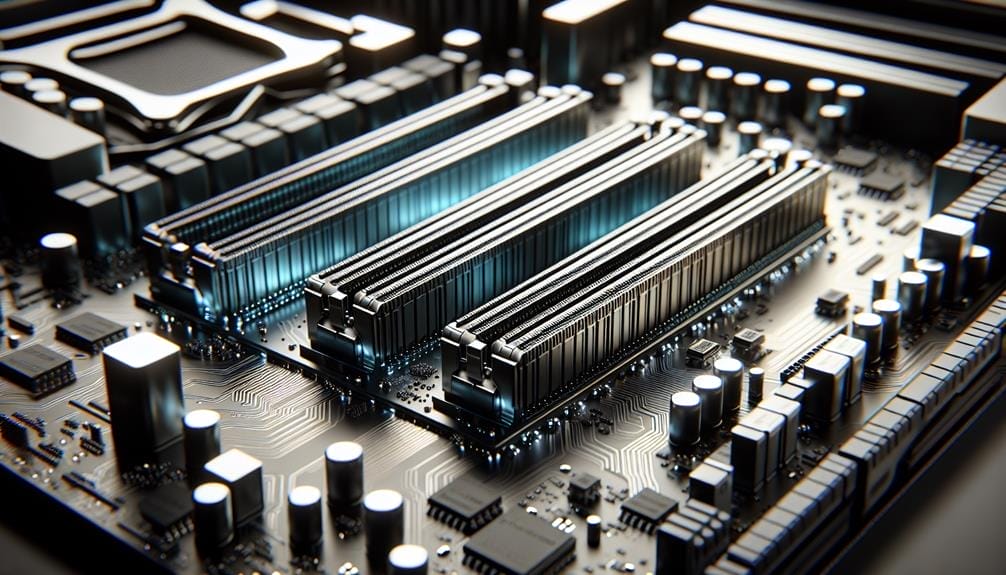
Intel's adoption of DDR4 memory technology provides a significant advantage in terms of cost-effectiveness and widespread compatibility across a range of desktop motherboards. DDR4 support allows for faster data transfer rates, improved power efficiency, and higher module densities compared to its predecessor, DDR3.
In terms of motherboard pricing, Intel's DDR4 support has led to a more competitive market, with a wide variety of affordable options available for consumers. Additionally, DDR4's compatibility with a broad range of Intel processors ensures that users have access to a diverse selection of motherboards with varying features and performance levels.
This advantage makes Intel's DDR4-supported motherboards a compelling choice for users seeking reliable and cost-effective options for their PC builds.
Wi-Fi and Additional Features
Considering the increasing demand for seamless connectivity and enhanced functionality in modern PC builds, the integration of Wi-Fi and additional features has become a pivotal consideration for motherboard selection.
- Price Variations:
AMD motherboards tend to offer better value for money in terms of Wi-Fi and additional features, often including them in mid-range and even some budget options. In contrast, Intel motherboards may require a higher budget for similar Wi-Fi and additional feature integration.
- Compatibility with Older CPUs:
AMD has a better track record of backward compatibility with older CPUs, ensuring that older processors can still be used with newer motherboards. Intel, on the other hand, frequently introduces changes in CPU sockets, limiting compatibility with older CPUs.
This highlights the need for thorough research and consideration of individual preferences and requirements when selecting a motherboard based on Wi-Fi and additional features.
Future-Proofing With DDR5
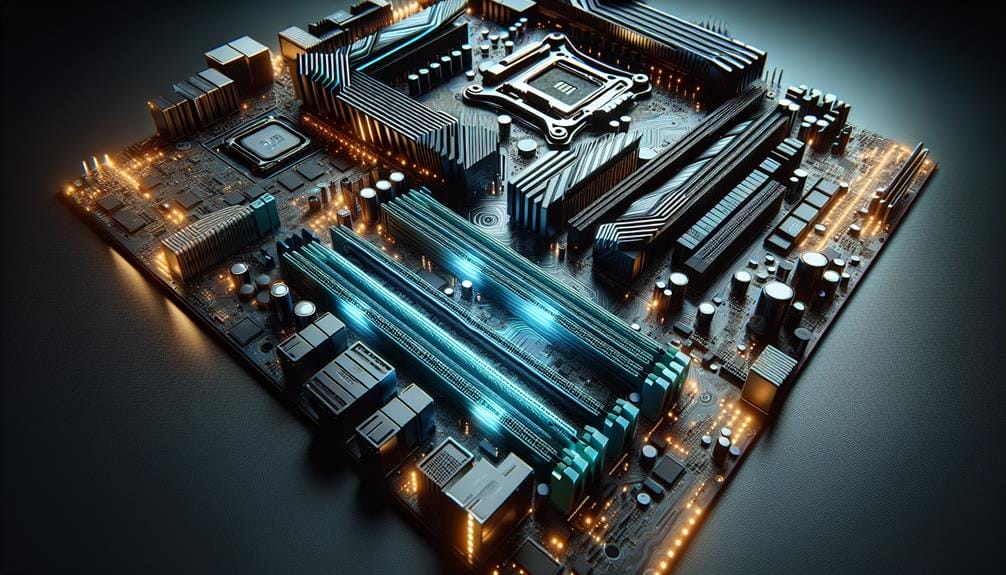
The increasing integration of Wi-Fi and additional features in modern PC builds has become a pivotal consideration for motherboard selection. As technology progresses, future-proofing with DDR5 memory is emerging as a critical aspect for ensuring long-term compatibility and performance.
DDR5 brings several benefits for future-proofing, including higher memory bandwidth, increased capacity, and improved power efficiency compared to DDR4. These advancements can significantly impact motherboard performance, enabling faster data transfer speeds, enhanced multitasking capabilities, and better support for demanding applications and gaming. Additionally, DDR5's improved error correction capabilities contribute to greater system stability and reliability.
As DDR5 becomes more prevalent, selecting a motherboard with DDR5 support will be crucial for users seeking to build systems that can keep up with evolving software and hardware requirements.
Additional Resources and Community
For comprehensive insights and extensive technical discussions on motherboard selection, performance comparisons, and future-proofing considerations, the CGDirector forum offers a valuable platform for enthusiasts and experts alike.
- Expert guidance: Engage in forum discussions with experienced users and experts to gain valuable insights into motherboard selection and performance comparisons.
- Buying guides: Access detailed buying guides and recommendations to make informed decisions when choosing between AMD and Intel motherboards.
- Troubleshooting support: Seek assistance and troubleshooting support from the community to address any issues related to motherboard compatibility or performance.
- Latest updates: Stay updated with the latest developments and advancements in motherboard technology through discussions and shared knowledge within the community.
Conclusion
In conclusion, the comparative analysis of AMD and Intel motherboards provides valuable insights into the technical specifications, compatibility, and future prospects of these platforms.
By examining factors such as price, features, overclocking capabilities, socket and RAM requirements, as well as future-proofing with DDR5, consumers can make informed decisions when selecting a motherboard for their PC build.
This in-depth exploration of the differences between AMD and Intel motherboards enhances understanding of the evolving landscape of PC hardware.

